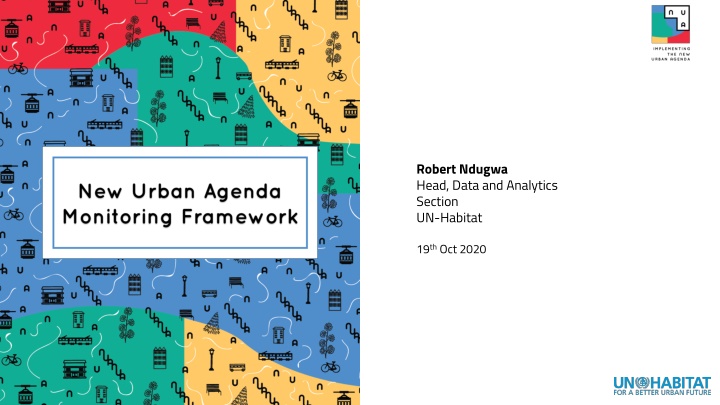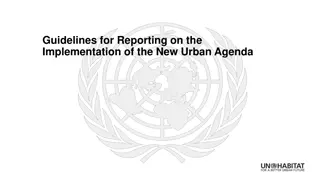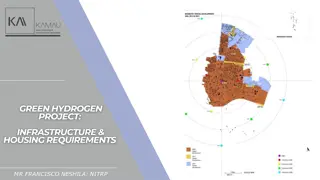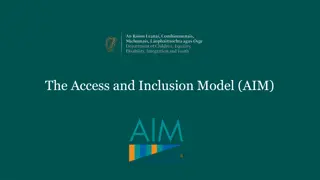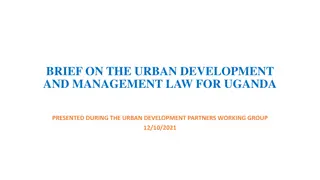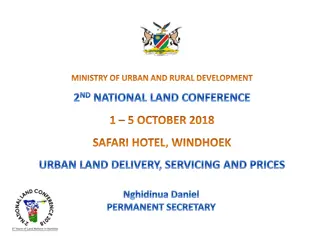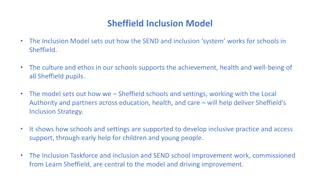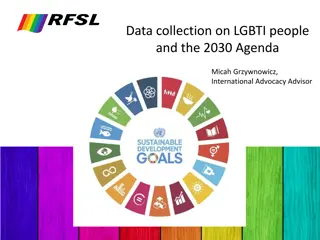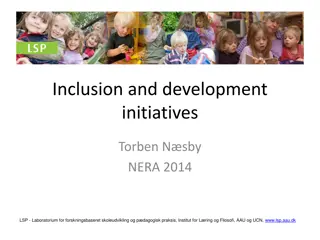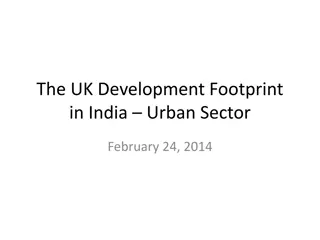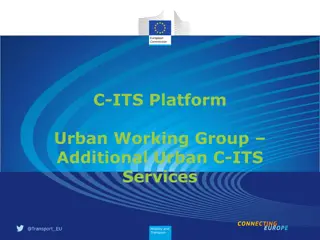Monitoring Framework for Effective Urban Development and Inclusion
The New Urban Agenda (NUA) monitoring framework focuses on transformative commitments for social inclusion and poverty eradication in urban areas. It includes indicators like poverty levels, unemployment rates, legal rights, and equality in housing. The framework aims to enhance social inclusion and ensure access to public spaces for all, addressing key urban development challenges.
Download Presentation

Please find below an Image/Link to download the presentation.
The content on the website is provided AS IS for your information and personal use only. It may not be sold, licensed, or shared on other websites without obtaining consent from the author.If you encounter any issues during the download, it is possible that the publisher has removed the file from their server.
You are allowed to download the files provided on this website for personal or commercial use, subject to the condition that they are used lawfully. All files are the property of their respective owners.
The content on the website is provided AS IS for your information and personal use only. It may not be sold, licensed, or shared on other websites without obtaining consent from the author.
E N D
Presentation Transcript
Robert Ndugwa Head, Data and Analytics Section UN-Habitat 19th Oct 2020
NUA Guidelines circulation WUF 10 9/2019 8/2020 3/2022 4/3/2019 2/2020 1/2022 6/2022 Framework development with internal and external consultation e.g RECS, MS, civil society, academia, etc Preparation of Quadrennial Report to the General Assembly on NUA implementation NUA Guidelines circulation Data collection based on NUA Monitoring Framework; Production of voluntary country reports on NUA implementation based on the Monitoring Framework.
The New Urban Agenda monitoring framework Transformative commitments Effective implementation Planning and Managing Urban Spatial Development Sustainable and inclusive urban prosperity and opportunities for all Environmentally sustainable and resilient urban development Social Inclusion and Ending Poverty Building Governance Structure Means of Implementation Categories Sub 3 Sub-categories 2 Sub-categories 2 Sub-categories 6 Sub-categories 7 Sub-categories 3 Sub-categories Categories a) NUA draws on many global frameworks such as SDGs b) Total of 77 indicators in the current draft combines quantitative and qualitative measures
Transformative commitments: Social Inclusion and Ending Poverty 1: Proportion of population below the international poverty line, by sex, age at national urban level Eradicate poverty 10: Unemployment rate by sex, age, persons with disabilities and by city 33: Gini coefficient at national/ city/ urban levels; Address inequality in urban areas 4Women s recognised legal right to property inheritance and ownership 1.Social Inclusion and Ending Poverty Social Inclusion and Ending Poverty 34 Presence of national legislation forbidding discrimination in housing, access to public facilities and social services on the basis of race, colour, sex, language, religion, political or other opinion, national or social origin, property, birth or other status Enhance social inclusion Ensure access to public spaces 19: Average share of the built-up area of cities that is open space for public use for all, by sex, age and persons with disabilities. 35: Percentage of road length that has dedicated bike lanes (excluding motorways). 36: Percentage of road length that has dedicated sidewalks (excluding motorways). 4
Transformative commitments: Social Inclusion and Ending Poverty 31: Median amount of money spent on housing and transportation per household as a percentage of the median annual household income of tenants. Ensure access to adequate and affordable housing 32: Ratio of the median free-market price of a dwelling unit and the median annual household income 38: Percentage of people living in affordable housing Ensure access to sustainable housing finance options 37: Mortgage debt relative to GDP 2.Access to Adequate Housing Social Inclusion and Ending Poverty 2: Proportion of total adult population with secure tenure rights to land with (a) legally recognized documentation; and (b) who perceive their rights to land as secure, by sex and type of tenure Support security of tenure Establish slum upgrading programmes 39: Proportion of cities with slum upgrading programmes 41 Percentage of cities that have integrated housing policies and regulations in their local development plans 40: Number of cities having annual budget allocations addressing any of the 5 slum deprivations and inclusive public spaces in known slum areas 42 Total investment in housing (in both formal and informal sectors in the urban area), as a percentage of gross domestic product. Integrate housing into urban development plans 43 Percentage of government budget dedicated to housing subsidies 5
Transformative commitments: Social Inclusion and Ending Poverty 5: Proportion of population using safely managed drinking water services; 6: Proportion of population using safely managed sanitation services; Access to safe drinking water, sanitation 18: Proportion of municipal solid waste collected and managed in controlled facilities out of total Municipal Solid Waste generated by cities. Access to safe and efficient public transport system 44: Percentage of commuters using public transport 3.Access to Basic Services Social Inclusion and Ending Poverty Access to modern renewable energy 7: Renewable energy share in the total final energy consumption Access to Information Communication technology (ICT) 25: Fixed Internet broadband subscriptions per 100 inhabitants, by speed 6
Transformative commitments: Sustainable and inclusive urban prosperity and opportunities for all 11: Proportion of youth (aged 15- 24 years) not in education, employ ment or training Promote productive employment for all 8: Annual growth rate of real GDP per employed person Support the informal economy 9: Proportion of informal employment in non-agriculture employment, by sex Sustainable and inclusive urban prosperity and opportunities for all 1.Inclusive Urban Economy Support small- and medium-sized enterprises 45: Small and medium-sized enterprises percentage share of GDP Promote an enabling, fair and responsible environment for business and innovation 26: Number of days to register a new business in the country 7
Transformative commitments: Sustainable and inclusive urban prosperity and opportunities for all 46: Employment in cultural and creative industries of as proportion of total employment Support the diversification of the urban economy 12: Manufacturing employment as proportion of total employment 2.Sustainable Urban Prosperity Sustainable and inclusive urban prosperity and opportunities for all Develop technical and entrepreneurial skills 47: Annual number of vocational and technical education individuals trained Strengthen urban- rural linkages to maximize productivity 20: Does your country have a National Urban Policy or Regional Development Plan that (a) responds to population dynamics, (b) ensures balanced territorial development, and (c) increase in local fiscal space 8
Transformative commitments: Environmentally sustainable and resilient urban development 15: Ratio of land consumption rate to population growth rate. 48: Percentage of land under protected natural areas. Address urban sprawl and loss of biodiversity 49: Percentage of local governments that adopt and implement local disaster risk reduction strategies in line with national strategies. 50: Percentage subnational/local government with budgets dedicated to climate change mitigation and adaptation actions. 30: Annual mean levels of fine particulate matter (e.g. PM2.5 and PM10) in cities (population weighted) 3: Mortality rate attributed to household and ambient air pollution Climate change mitigation and adaptation actions 1.Resilience, Mitigation, and Adaption of Cities and Human Settlements Environmentally sustainable and resilient urban development Develop systems to reduce the impact of natural and human- made disasters Build urban resilience through quality infrastructure and spatial planning 52: Does the country have a multi-hazard monitoring and forecasting system? 9
Transformative commitments: Environmentally sustainable and resilient urban development 54: Existence of an enforced coastal and/or land management plan. 23: Recycling rate, tons of material recycled. Implement environmentally sound management of water resources and coastal areas 21: Material footprint, material footprint per capita, and material footprint per GDP. Promote resource conservation and waste reduction, reuse, and recycling 2.Sustainable Management and use of natural resources 22: Domestic material consumption, domestic material consumption per capita, and domestic material consumption per GDP. Environmentally sustainable and resilient urban development Strengthen the sustainable management of natural resources in urban areas 27: Green Area per capita 55: Percentage reduction in annual final energy consumption in homes using smart monitoring systems. Adopt a smart-city approach that leverages digitization, clean energy and technologies 56: Share of street junction with traffic lights connected to traffic management systems . 10
57: Do local authorities exercise their authority and fulfil their responsibilities in accordance with such procedures and in such cases as provided for by the constitution or by law? Effective implementation: Building Governance Structure: Establishing a supportive Framework 58: Percentage of the total budget that the local / sub-national government have discretion over to decide on priorities (financial autonomy) Decentralization to enable subnational and local governments undertake their assigned responsibilities 59: Percentage of the local / sub-national government s financial resources generated from endogenous (internal) sources of revenue Linking urban policies to finance mechanisms and budgets 59: Percentage of the local / sub-national government s financial resources generated from endogenous (internal) sources of revenue Legal and policy frameworks to enhance the ability of governments to implement urban policies Building Governance Structure: Establishing a supportive Framework 60: Quality of law Strengthen the capacity of local and subnational governments to implement local and metropolitan multilevel governance 61: Published performance delivery standards at the sub-national level 16: Proportion of cities with a direct participation structure of civil society engagement in urban planning and management, which are regular and democratic. Promote participatory, age- and gender- responsive approaches to urban policy and planning 24: Proportions of positions (by sex, age, persons with disabilities and population groups) in public institutions (national and local legislatures, public service, and judiciary) compared to national distributions Promote women s full participation in all fields and all levels of decision-making
Effective implementation: Planning and Managing Urban Spatial Development 20: Does the country have a National Urban Policy or Regional Development Plan that (a) responds to population dynamics, (b) ensures balanced territorial development, and (c) increase in local fiscal space. 62: Number of countries, regional governments, and cities in which plans and designs are publicly accessible to residents (on-line) and can be consulted at all times Integrated and balanced territorial development policies Integrate housing into urban development plans 13: Proportion of urban population living in slums, informal settlements or inadequate housing. 17: Total expenditure (public and private) per capita spent on the preservation, protection and conservation of all cultural and natural heritage, by type of heritage, level of government, type of expenditure and type of private funding Inclusion of culture as a priority component of urban planning Planning and Managing Urban Spatial Development Planned urban extensions and infill, urban renewal and regeneration of urban areas 28: Population Density 29: Land-use mix Improved capacity for urban planning and design, and training for urban planners at all levels of government Strengthening the role of small and intermediate cities and towns 63: Number and percent of new population accommodated in a plan or city extension 64: Number of urban planners per 100,000 persons Promote sustainable multimodal public transport systems including non-motorized options
Effective implementation: Means of Implementation Mobilization of Financial Resources Means of Implementation Capacity Development Information Technology and Innovation
Mobilization of financial resources 1.Mobilization of financial resources Mobilize endogenous (internal) sources of finance and expand the revenue base of subnational and local governments Promote sound systems of financial transfers from national to subnational and local governments based on needs, priorities and functions Mobilize and establish financial intermediaries (multilateral institutions, regional development banks, subnational and local development funds; pooled financing mechanisms etc.) for urban financing Develop financing frameworks for implementing the NUA at all levels of government 65: Existence of structure or office or committee or taskforce for implementing the New Urban Agenda 58: Percentage of the total budget that the local / sub-national government have discretion over to decide on priorities (financial autonomy) 59: Percentage of the local / sub-national government s financial resources generated from endogenous (internal) sources of revenue 66: Stable existence of transfer formula in the last 5 years, without major changes, meaning reductions of more than 10%. 67: Existence of at least one finance or infrastructure fund available for local governments. 68: Percentage of the local / sub-national government s financial resources generated from financial intermediaries such as multilateral institutions, regional development banks, subnational and local development funds, or pooled financing mechanisms.
Next steps Capacity building for all stakeholders Development of e-learning materials Data production and continuous consultations with all stakeholders
Presenter name Unit UN-Habitat Robert Ndugwa robert.ndugwa@un.org DateThank You
